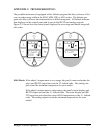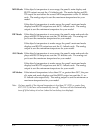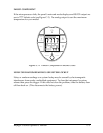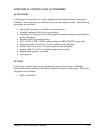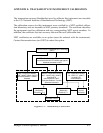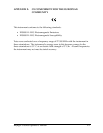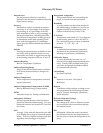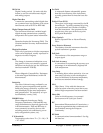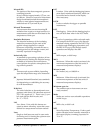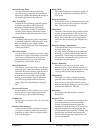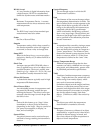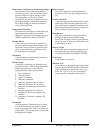
Raynger 3i Series Operator's Manual Glossary-5
RS-232 (1-way)
A 1-way transfer of digital information from
a digital output. RS-232 is a standardized
format for asynchronous serial data transfer.
RTD
Resistance Temperature Device. A contact
measurement device whose resistance varies
with temperature.
RUN
The RUN Loop is used when standard spot
measurements need to be taken.
Scatter
See Size of Source Effect.
Setpoint
Temperature setting which when crossed by
the actual temperature value will trigger an
event and/or cause a relay to change state.
Setup (SET)
When in the Setup Loop, you can set values
(emissivity, alarms, etc.) in either the RUN or
LOG Loops.
Shock Test
An impact test per MIL-STD-810D where a
force is applied to any axis of an object over a
specified duration. The force is usually mea-
sured in g’s (1g = 9.81m/s
2
= 32.2 ft./s
2
), and
the duration is usually measured in msec.
Silicon (Si) Detector
A photodiode detector typically used in high
temperature IR thermometers.
Size of Source Effect
An undesirable increase in temperature read-
ing caused by IR energy outside the spot
reaching the detector. The effect is most pro-
nounced when the target is much larger than
the field of view.
Sleep
Units with this feature go to “sleep” either
immediately or after a period of inactivity
(depending on the Loop). Sleep is a period of
low power consumption, no display, no
laser, and no backlight.
Spectral Filter
An optical element used to restrict the spec-
tral band of energy reaching an instrument’s
detector.
Spectral Response
The wavelength region in which the IR
Thermometer is sensitive.
Spot
The diameter of the area on the target where
the temperature determination is made. The
spot is defined by the circular aperture at the
target which allows typically 90% of the IR
energy to be collected by the instrument, as
compared with the 100% spot diameter
which is defined by the IR energy collected
from a very large target. The actual size and
distance to the target for the 100% spot diam-
eter is specified in the calibration procedure
for each instrument.
Stare
A saturation effect caused by aiming a sensor
at a “hot” target for an extended period of
time and then quickly aiming at a target at a
“lower” temperature. The increase in time
(beyond the normal system response) for the
sensor to return to within 5 % of the lower
temperature is defined as the “stare” time.
Storage Temperature Range
Ambient temperature range that the ther-
mometer can safely withstand in a non-oper-
ating mode, and subsequently, operate with-
in published performance specifications.
TAM
T-ambient (Ambient temperature compensa-
tion). Targets that have low emissivities will
reflect energy from nearby objects, which
may result is inaccurate readings.
Sometimes objects near the target (machines,
furnaces, or other heat sources) have a tem-
perature much higher than that of the target.
In these situations it is necessary to compen-
sate for the reflected energy from those
objects. (TAM has no effect if the emissivity
is 1.0.)
Target
The object upon which the temperature
determination is intended to be made.
Temperature
A degree of hotness or coldness of an object
measurable by a specific scale; where heat is
defined as thermal energy in transit, and
flows from objects of higher temperature to
objects of lower temperature.



